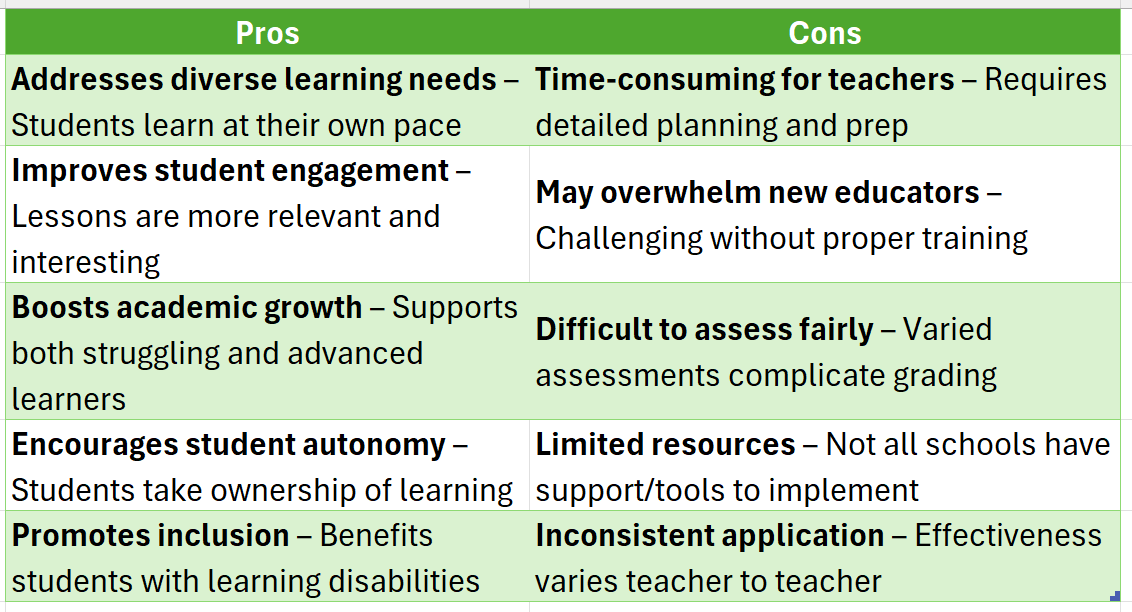
Differentiated education is like a treasure map for teachers, guiding them to engage every student uniquely. When students feel connected to their learning, they become more interested and motivated. This approach matters because it helps all learners thrive, regardless of their starting point.
What is Differentiated Education?
Differentiated education tailors lessons to meet diverse student needs. It considers different learning styles, interests, and readiness levels. By customizing curriculum design, teachers can create a more inclusive classroom where everyone can shine.
Benefits of Differentiated Education
- Increased Engagement: Students are more likely to participate when lessons resonate with them.
- Boosted Confidence: Tailored learning helps students feel successful, which builds their self-esteem.
- Improved Outcomes: Research shows that differentiated instruction leads to better academic performance.
How to Implement Differentiated Education
Teachers can use strategies learned in a master’s in instructional design program to create engaging lessons. They can group students by skill level, offer choices in assignments, or provide various resources. This flexibility allows students to learn in ways that suit them best, making education a more enjoyable adventure!
Unlock your potential with online degrees—Learn more!
How Differentiated Education Meets Diverse Learning Needs

Differentiated education is like a magic key that unlocks the potential of every student. When teachers tailor their lessons to meet diverse learning needs, students feel more engaged and excited about learning. This approach is essential because it recognizes that not everyone learns the same way, making education more inclusive and effective.
Understanding Individual Differences
Differentiated education focuses on understanding each student’s unique strengths and challenges. By using various teaching methods, such as group work, hands-on activities, and technology, teachers can create a curriculum design that resonates with every learner. This personalized approach helps students connect with the material, boosting their motivation and engagement.
Benefits of Differentiated Education
- Increased Engagement: When lessons are tailored, students are more likely to participate actively.
- Improved Understanding: Differentiation helps clarify complex concepts, making them easier to grasp.
- Higher Achievement: Students often perform better when they learn in ways that suit their individual needs.
For educators pursuing a master’s in instructional design, mastering differentiated education techniques is crucial. It equips them with the skills to create engaging and effective learning experiences for all students, ensuring that no one is left behind.
The Role of Teacher Creativity in Differentiated Education
Differentiated education is all about meeting students where they are. When teachers tailor their lessons to fit individual learning styles, it sparks interest and keeps students engaged. This approach not only makes learning fun but also helps students feel valued and understood. Let’s dive into how teacher creativity plays a vital role in this process.
Engaging Curriculum Design
Creative teachers use differentiated education to design a curriculum that resonates with their students. By incorporating various activities—like group projects, hands-on experiments, and technology-based tasks—they cater to different learning preferences. This variety keeps students excited and eager to participate!
Benefits of Teacher Creativity
- Increased Engagement: When lessons are dynamic and interactive, students are more likely to stay focused.
- Personalized Learning: Teachers can adapt lessons based on individual needs, making learning more relevant.
- Fostering Independence: Creative approaches encourage students to take charge of their learning, boosting confidence.
Incorporating a master’s in instructional design can further enhance a teacher’s ability to create these engaging experiences. With the right training, educators can develop innovative strategies that truly resonate with their students, making learning an adventure rather than a chore.
Can Differentiated Education Foster a Love for Learning?
Can Differentiated Education Foster a Love for Learning? Differentiated education is like a treasure map for teachers, guiding them to discover what each student needs to thrive. When students feel their unique learning styles are recognized, they become more engaged. This approach transforms the classroom into a vibrant space where curiosity flourishes.
Why Engagement Matters
Engagement is crucial because it leads to deeper understanding and retention of knowledge. When students are actively involved, they are more likely to participate and enjoy the learning process. Differentiated education helps create this environment by tailoring the curriculum design to meet diverse needs.
Key Benefits of Differentiated Education
- Personalized Learning: Students receive instruction that matches their interests and abilities.
- Increased Motivation: When lessons resonate, students are more excited to learn.
- Improved Collaboration: Working in diverse groups fosters teamwork and communication skills.
Incorporating differentiated education into the curriculum design can spark a love for learning. Teachers who pursue a master’s in instructional design are equipped with the skills to create engaging, customized lessons that cater to all learners. This not only enhances student engagement but also builds a lifelong passion for knowledge.
Unlock your potential with online degrees—Learn more!
Real-World Examples of Differentiated Education in Action
Differentiated education is more than just a teaching method; it’s a way to connect with students on their level. When teachers tailor their curriculum design to meet diverse learning needs, students feel more engaged and motivated. This approach not only enhances understanding but also fosters a love for learning. Let’s explore some real-world examples that illustrate this powerful concept.
Personalized Learning Paths
One school in California implemented personalized learning paths for its students. Each student received a tailored curriculum based on their interests and learning styles. For instance, while some students thrived in hands-on science experiments, others excelled in reading comprehension through storytelling. This flexibility allowed students to take ownership of their education, leading to increased participation and enthusiasm in class.
Collaborative Projects
Another example comes from a middle school in Texas, where teachers introduced collaborative projects. Students worked in groups to tackle real-world problems, like designing a community garden. By integrating subjects like math, science, and art, students saw the relevance of their studies. This approach not only improved engagement but also prepared them for future teamwork, a skill emphasized in master’s in instructional design programs.
How CollegeAndTuition.com Supports Educators in Implementing Differentiated Strategies
Differentiated education is a game-changer in classrooms. It tailors learning experiences to meet the diverse needs of students, making lessons more engaging and effective. When students feel their unique learning styles are acknowledged, they become more involved and excited about their education. This is where CollegeAndTuition.com steps in to support educators.
Tailored Curriculum Design
At CollegeAndTuition.com, we believe that every student deserves a chance to shine. Our resources help teachers design a curriculum that caters to various learning preferences. By providing tools for creating personalized lesson plans, we empower educators to engage students in ways that resonate with them.
Professional Development Opportunities
Educators looking to enhance their skills can benefit from our master’s in instructional design programs. These courses equip teachers with the knowledge to implement differentiated strategies effectively. With a solid foundation in curriculum design, they can create dynamic learning environments that captivate students’ attention and foster a love for learning.
Engaging Learning Environments
Creating an engaging classroom is essential. With differentiated education, teachers can use various teaching methods, such as group work, hands-on activities, and technology integration. This variety keeps students interested and motivated, allowing them to explore subjects in ways that excite them.
Building Stronger Relationships
Differentiated education also helps build stronger relationships between teachers and students. When educators understand individual needs, they can provide personalized feedback and support. This connection fosters trust and encourages students to take risks in their learning, knowing they have a supportive guide by their side.
Measuring the Impact of Differentiated Education on Student Engagement
Measuring the impact of differentiated education on student engagement is essential. When teachers tailor lessons to meet diverse learning needs, students feel more connected to their education. This connection fosters curiosity and motivation, transforming learning into an exciting adventure rather than a chore.
Understanding Differentiated Education
Differentiated education involves adjusting curriculum design to fit each student’s unique strengths and interests. Some students thrive with hands-on projects, while others prefer reading or group discussions. This variety keeps everyone engaged and eager to learn.
Benefits of Differentiated Education
- Increased Motivation: Students participate more when lessons resonate with them.
- Improved Confidence: Tailored instruction helps students succeed at their own pace, boosting self-esteem.
- Better Collaboration: Diverse group work encourages teamwork and communication skills, essential for future success.
In conclusion, implementing differentiated education strategies creates an environment where every student can shine. This enhances engagement and prepares students for real-world challenges, making a master’s in instructional design invaluable for educators. Additionally, teachers can use various tools and methods to create engaging lessons that cater to different learning styles, making education more interactive and fun. Schools can track student engagement through surveys and performance metrics to understand the impact better. By continuously learning and adapting their strategies, teachers ensure that every student feels valued and included.
Unlock your potential with online degrees—Learn more!
FAQs
1. What is differentiated education?
Differentiated education is a teaching approach that tailors instruction to meet the diverse needs, skills, and learning styles of individual students.
2. Why is differentiated instruction important?
It helps ensure that all students, regardless of ability level, are challenged appropriately and can learn effectively in the same classroom.
3. How do teachers differentiate instruction?
Teachers may adjust content, process, product, or learning environment based on student readiness, interests, or learning profiles.
4. Is differentiated instruction only for students with special needs?
No, it benefits all students—advanced learners, struggling students, English language learners, and everyone in between.
5. What are some examples of differentiation in the classroom?
Examples include using tiered assignments, offering choice in projects, flexible grouping, and providing multiple ways to access content.
6. Does differentiated instruction mean more work for teachers?
It requires thoughtful planning but often becomes easier with experience and can lead to more effective and engaging teaching.
Related Articles
- Is a Master’s in Instructional Design Worth It for Teachers?
- Can Effective Curriculum Design Boost Learning Outcomes?
- What Do Curriculum Specialists Do in K-12 Schools?
- How to Choose the Best Instructional Design Online Degree?
- Where to Find High-Paying Curriculum Specialist Jobs in 2025
- Are Instructional Games for Students Effective Learning?
- What Skills Are Needed for Curriculum Designer Jobs? A Guide
- Top Affordable Instructional Design Master’s Online Programs
- How Does Educational Design Impact Classroom Success?
- Is Master in Data Science and Artificial Intelligence Right?
- How Can Instructional Empowerment Transform Practices?
- What Are the Benefits of an EdD Instructional Design Online?
- How Does Curriculum Compacting Support Gifted Students?
- Data Science, AI, and Machine Learning for Educators in 2025
- How Do Instructional Rounds Improve Teacher Collaboration?






